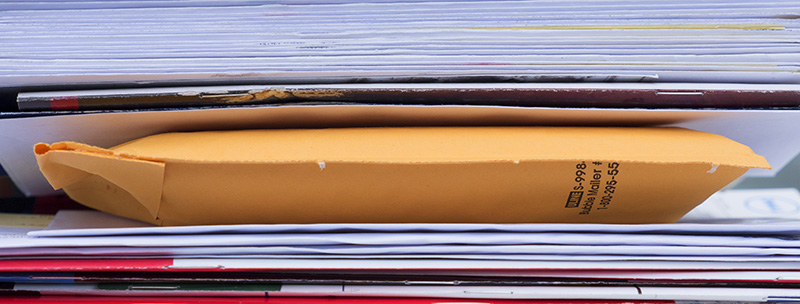 Which envelope would you open first?
Which envelope would you open first?
How many emails do you trash every day, without even looking at the content? Current statistics tell us that about 70% of email is spam, so your “trash that” number is likely in that range.
Most of us know that a good email campaign will yield a 2-3% click through rate. (http://mailchimp.com/resources/research/email-marketing-benchmarks/) That’s a good campaign with the research provided by an email delivery service. Many campaigns deliver less than a 2% open rate and, of those, the conversion rate is typically less than half, or less than 1% of sends. (http://www.idealware.org/articles/email_metrics.php)
Direct mail, on the other hand, has found that through personalization, quality of printing and perceived value that people open and review the contents of direct mail promotions on a much more regular basis.
The US Postal Service (Current Initiatives Study http://about.usps.com/current-initiatives/studying-americans-mail-use.htm) indicates that the majority of people who receive direct mail advertising give it their attention. With a response rate of 10% being a ten-fold increase over email campaigns, it is not surprising that direct mail is on the increase although at a slower than might be expected rate given those numbers.
The recession took a big bite out of direct mail because, frankly, the population simply stopped buying anything for a while. When those trends reversed, marketing costs were being scrutinized at the corporate level and many marketing professionals lost site of the larger gains available through direct mail as compared to the low cost of email campaigns.
Yes, direct mail costs more, and effective direct mail often has an even higher price tag associated with it. But with a conversation rate 1000% higher, it becomes obvious that the cost is in many cases justified. The question becomes, how do we make our direct mail campaigns achieve or surpass even those superior average return rates?
Very simply, put something of value in your delivered piece. Make it instantly recognizable to the touch that there is something in the envelope, or better yet, in the small package. Something three-dimensional, more than a piece of paper in clear envelopes or a postcard, gets immediate attention.
Curiosity is a compelling desire, and nothing inspires curiosity like a closed package with something in it. Only the unknown can elicit the need to know. A piece of paper in an envelope? Junk mail. Something solid, some molecules made into something that can’t quite be deciphered by touch alone? The need to open and inspect is immediate.
It is the tactile sense that creates the engagement, as the mail is being sorted into the “open” and “trash” piles. Those flat items, no matter how creatively adorned with the facia of importance of health, tax savings and profit potential, all addressed to the recipient by name and address, hit the trash with incredible speed.
Recognition of something more than a piece of paper enclosed in an envelope is immediate. With that touch, a person is facing the question, “What is that in there?” and the urge to open often supersedes the sorting of the rest of the mail. This is where the sender has to be smart, witty even, and find the right item to engage their customer with. A product sample is a good start, honest and worthy. Either the customer tries it and appreciates the qualities, or they don’t. Very clear cut.
Perhaps it is the key to a car, “C’mon in and see if it fits!” is a perfect way to drive traffic to a new car showroom. Simpler promotional items can work, too. Perhaps a small box of toothpicks for a BBQ joint, an eyeglass cloth for an optometrist, dental floss for a dentist or a visor mounted tissue holder for an auto mechanic. A catchy tagline and logo go far, too, but for the sake of this article we’ll leave that to your marketing department.
When Scotland based L.J. Market Research ran their study of brand retention among U.S. consumers they found that 27% of people remember banner ads a week after seeing them, 53.5% remember print and TV ads a week later but 76% remember the brand on promotional items a full year later.
From the same report, 52% of promotional item recipients did business with the advertiser after receiving the promotional product. Of those that hadn’t done business with the advertiser, almost half, that is another 25%, said they were more likely to do business with that company after receiving the promotional item.
Aside from a quality personal or professional relationship and referral, nothing creates awareness of your brand – and that is you as well as your company – than putting that brand in the potential customers hand.
The simple point being made here is this: digital touches add up, but nothing succeeds like the real thing.
With this knowledge the questions become – how do you get these promotional items out? How many can you deliver? At what cost?
Getting 100 of anything and giving them to your paying customers is a nice thing to do, and something you should do to build that relationship, but it won’t bring many new customers in the door. Going to an event with your target customers as a high demographic might yield some new opportunities, and face to face meetings are always good, but those are limited numbers and even in the best of circumstances, unknown demographics.
What if you sent out 1000 promotional items to prime contacts in your area? Or a very select list of 250?
What is a new customer worth to you?
Priority Pak, one of the leading Southern California fulfillment shops, works with businesses of all sizes providing quality assembly, kitting, packaging and delivery services. Some projects are for thousands per month, others a few per day. Consistent and timely service along with concise and complete communications are the keys to our continued success. Contact us to help with the planning and delivery of your next promotional campaign!
